Spatiotemporal Dynamics and Drivers of Coastal Wetlands in Tianjin–Hebei over the Past 80 Years
Abstract
1. Introduction
2. Materials and Methods
2.1. Study Area
2.2. Data Source
2.2.1. Coastal Area Images
2.2.2. Topographic Map Data
2.2.3. Field Survey Data
2.3. Methods
2.3.1. Definition and Classification of Coastal Wetlands
2.3.2. Extraction Methods for Coastal Wetlands
2.3.3. Calculation Method for Wetland Dynamic Changes
2.3.4. Trajectory Analysis Method
2.3.5. Landscape Pattern Analysis Method
3. Results
3.1. Changes in Coastal Wetland Area
3.1.1. Coastal Wetland Area Changes in Total
3.1.2. Coastal Wetland Area Changes in Different Cities
3.2. Changes in Coastal Wetland Landscape Patterns and Types
4. Discussion
4.1. Analysis of Driving Mechanisms
4.2. Analysis of Ecological and Environmental Problems Caused by Changes in Coastal Wetlands
4.3. Suggestions for Protection and Restoration
4.3.1. Addressing the Decline in Natural Wetlands
- Government authorities should enact rigorous regulations and policies aimed at halting further development and destruction of natural wetlands. This includes stringent measures to protect existing wetlands and prevent their degradation [60].
- Focus should be on ecological restoration initiatives in heavily impacted wetland areas. Strategies may include reclaiming aquaculture zones for wetland purposes, restoring enclosed areas to their natural wetland state, and reintegrating coastal areas with wetlands. These efforts aim to progressively enhance the extent and quality of natural wetland habitats [61].
4.3.2. Addressing Wetland Fragmentation
- It is crucial to establish ecological corridors between wetlands to maintain connectivity within wetland ecosystems. These corridors facilitate the movement and genetic exchange of wetland biopopulations, thereby promoting ecological resilience and biodiversity conservation [62].
- Addressing human-induced disruptions to wetland hydrology is essential. Remedial measures, such as installing controllable tidal gates and optimizing drainage networks, should be prioritized. These actions aim to stabilize and enhance the hydrological conditions necessary for sustainable wetland ecosystems.
5. Conclusions
- Overall, the coastal wetland area has shown a pattern of decrease, increase, and then a subsequent decrease, though it remains relatively extensive in the current period. Specifically, Tianjin and Tangshan have experienced fluctuating increases in wetland areas historically, with recent decades showing a decline. In contrast, Cangzhou has seen a fluctuating decrease in wetland areas.
- Coastal wetlands have undergone significant landscape changes, particularly with an increase in fragmentation. The primary change in wetland types is the conversion of wetlands into non-wetlands.
- In response to the observed changes and challenges in coastal wetlands over the past eight decades, we recommend the following: First, strengthen wetland protection policies and enforce strict regulations to prevent further degradation. Second, focus on restoring damaged wetlands and expanding natural wetland habitats. Establish ecological corridors to improve connectivity and support the migration of species. These measures are essential for preserving coastal wetland ecosystems, protecting biodiversity, and promoting sustainable development.
Author Contributions
Funding
Data Availability Statement
Acknowledgments
Conflicts of Interest
References
- Li, C.; Wang, F.; Yang, P.; Wang, F.C.; Hu, Y.Z.; Zhao, Y.L.; Tian, L.; Zhao, R. Assessment ecological risk of heavy metal caused by high-intensity land reclamation in Bohai Bay, changing trend analyzation and carbon storage assessment of China. China Geol. 2024, 7, 1–11. [Google Scholar] [CrossRef]
- Bn, P.O.T. Ramsar Convention on Wetlands. Ramsar Fact Sheet 3 Wetlands: A Global Disappearing Act 2015. Available online: https://www.ramsar.org/sites/default/files/documents/library/factsheet3_global_disappearing_act_0.pdf (accessed on 16 March 2024).
- Ye, S.; Pei, L.; He, L.; Xie, L.; Zhao, G.; Yuan, H.; Laws, E.A. Wetlands in China: Evolution, Carbon Sequestrations and Services, Threats, and Preservation/Restoration. Water 2022, 14, 1152. [Google Scholar] [CrossRef]
- The State Forestry Administration of The Peoples’s Republic of China. China Wetlands Resource; China Forestry Publishing House: Beijing, China, 2015. [Google Scholar]
- Cui, B.; He, Q.; Gu, B.; Bai, J.; Liu, X. China’s Coastal Wetlands: Understanding Environmental Changes and Human Impacts for Management and Conservation. Wetlands 2016, 36, 1–9. [Google Scholar] [CrossRef]
- Ning, H.; Jiang, W.J.; Sheng, Y.Z.; Wang, K.L.; Chen, S.M.; Zhang, Z.; Liu, F.T. Comprehensive evaluation of nitrogen contamination in water ecosystems of the Miyun reservoir watershed, northern China: Distribution, source apportionment and risk assessment. Environ. Geochem. Health 2024, 46, 278. [Google Scholar] [CrossRef]
- Jiang, W.J.; Meng, L.S.; Liu, F.T.; Sheng, Y.Z.; Chen, S.M.; Yang, J.L.; Mao, H.R.; Zhang, J.; Zhang, Z.; Ning, H. Distribution, source investigation, and risk assessment of topsoil heavy metals in areas with intensive anthropogenic activities using the positive matrix factorization (PMF) model coupled with self-organizing map (SOM). Environ. Geochem. Health 2023, 45, 6353–6370. [Google Scholar] [CrossRef]
- Orimoloye, I.R.; Mazinyo, S.P.; Kalumba, A.M.; Nel, W.; Adigun, A.I.; Ololade, O.O. Wetland shift monitoring using remote sensing and GIS techniques: Landscape dynamics and its implications on Isimangaliso Wetland Park, South Africa. Earth Sci. Inform. 2019, 12, 553–563. [Google Scholar] [CrossRef]
- Dang, A.T.; Kumar, L.; Reid, M.; Nguyen, H. Remote Sensing Approach for Monitoring Coastal Wetland in the Mekong Delta, Vietnam: Change Trends and Their Driving Forces. Remote Sens. 2021, 13, 3359. [Google Scholar] [CrossRef]
- Zhu, J.F.; Zhou, Y.; Wang, S.X.; Wang, L.T.; Liu, W.L.; Li, H.Y.; Mei, J.J. Analysis of changes of Baiyangdian wetland from 1975 to 2018 based on remote sensing. Natl. Remote Sens. Bull. 2019, 23, 971–986. [Google Scholar] [CrossRef]
- Couvillion, B.R.; Beck, H.; Schoolmaster, D.; Fischer, M. Land Area Change in Coastal Louisiana (1932 to 2016); U.S. Geological Survey: Reston, VA, USA, 2017. [CrossRef]
- White, E.E., Jr.; Ury, E.A.; Bernhardt, E.S.; Yang, X. Climate change driving widespread loss of coastal forested wetlands throughout the North American coastal plain. Ecosystems 2021, 25, 812–827. [Google Scholar] [CrossRef]
- Bournazel, J.; Kumara, M.P.; Jayatissa, L.P.; Viergever, K.; Morel, V.; Huxham, M. The impacts of shrimp farming on land-use and carbon storage around Puttalam lagoon, Sri Lanka. Ocean. Coast. Manag. 2015, 113, 18–28. [Google Scholar] [CrossRef]
- Tian, B.; Wu, W.; Yang, Z.; Zhou, Y. Drivers, trends, and potential impacts of long-term coastal reclamation in China from 1985 to 2010. Estuar. Coast. Shelf Sci. 2016, 170, 83–90. [Google Scholar] [CrossRef]
- Cheng, M.; Huang, B.; Kong, L.; Ouyang, Z. Ecosystem spatial changes and driving forces in the Bohai coastal zone. Int. J. Environ. Res. Public Health 2019, 16, 536. [Google Scholar] [CrossRef] [PubMed]
- Zhu, G.; Xie, Z.; Li, T.; Ma, Z.; Xu, X. Assessment ecological risk of heavy metal caused by high-intensity land reclamation in Bohai Bay, China. PLoS ONE 2017, 12, e0175627. [Google Scholar] [CrossRef]
- Wei, F.; Han, G.X.; Zhang, J.P.; Li, Y.Z.; Zhao, J.M. Temporal and spatial dynamic evolution of coastal wetland under the action of sea reclamation in Bohai Rim during 1980–2015. Chin. J. Ecol. 2018, 37, 1527–1537. [Google Scholar] [CrossRef]
- Hou, X.Y.; Hou, W.; Wu, T. Shape changes of major gulfs along the mainland of China since the early 1940s. Acta Geogr. Sin. 2016, 71, 118–129. [Google Scholar] [CrossRef][Green Version]
- Ding, Y.; Wei, H. Research of the influential factors on the simulation of storm surge in the Bohai Sea. Open Mech. Eng. J. 2014, 8, 151–156. [Google Scholar] [CrossRef][Green Version]
- Wang, R.B.; Zhou, W.; Li, F.L.; Wang, H.; Yang, G.Y.; Yao, Z.J.; Kuang, S.J. Tectonic subsidence and prospect of ground subsidence control in Tianjin area. Hydrogeol. Eng. Geol. 2003, 5, 12–17. [Google Scholar] [CrossRef]
- McKee, M.; White, J.R.; Putnam-Duhon, L.A. Simulated storm surge effects on freshwater coastal wetland soil porewater salinity and extractable ammonium levels: Implications for marsh recovery after storm surge. Estuar. Coast. Shelf Sci. 2016, 181, 338–344. [Google Scholar] [CrossRef]
- Wang, H.; Shang, Z.W.; Wang, F. On the muddy coast, western Bohai Bay, China. Geol. Bull. China 2010, 29, 641–649. Available online: http://dzhtb.cgs.cn/en/article/id/20100502 (accessed on 4 April 2024).
- GB/T 24708-2009; Wetland Classification. National Forestry and Grassland Administration of China: Beijing, China, 2009.
- NH, R.K. Study of fluctuations in surface area of Lake Haramaya using NDWI and MNDWI methods. J. Geospat. Inf. Sci. Eng. 2022, 5, 36–41. [Google Scholar] [CrossRef]
- Chang, L.; Cheng, L.; Huang, C.; Qin, S.; Fu, C.; Li, S. Extracting urban water bodies from Landsat imagery based on mNDWI and HSV transformation. Remote Sens. 2022, 14, 5785. [Google Scholar] [CrossRef]
- Wang, S.; Zhang, L.; Zhang, H.; Han, X.; Zhang, L. Spatial–temporal wetland landcover changes of poyang lake derived from Landsat and HJ-1A/B data in the dry season from 1973–2019. Remote Sens. 2020, 12, 1595. [Google Scholar] [CrossRef]
- Liu, J.Y.; Wang, D.C.; Sun, R.H.; Wang, F.C.; Hu, B.X.; Chen, J.H.; Sun, Z.C. Study on spatial relevance of ecological-land loss based on change trajectory analysis method. Geographical Research. Geogr. Res. 2020, 39, 103–114. [Google Scholar] [CrossRef]
- Huang, Y.; Wang, F.Y.; Cai, T.J.; Wang, D.C.; Wang, Q.Q.; Chen, W.G. Landscape pattern dynamic analysis based on change trajectory method in Bohai rim area. J. Soil Water Conserv. 2015, 29, 314–319. [Google Scholar] [CrossRef]
- Zong, X.Y.; Gao, L.H.; Qiao, Y.L.; Lin, S. Study on dynamic changes of wetland landscape pattern in yellow river delta. J. Geo-Inf. Sci. 2009, 11, 91–97. [Google Scholar] [CrossRef]
- Li, Y.Z.; Yu, J.B.; Han, G.X.; Wang, X.H.; Wang, Y.L.; Guan, B. Dynamic evolution of natural wetlands in Yellow River Delta and related driving factors. Chin. J. Ecol. 2011, 30, 1535–1541. Available online: https://www.cje.net.cn/CN/Y2011/V30/I07/1535 (accessed on 5 April 2024).
- Bao, J.; Gao, S.; Ge, J. Dynamic land use and its policy in response to environmental and social-economic changes in China: A case study of the Jiangsu coast (1750–2015). Land Use Policy 2019, 82, 169–180. [Google Scholar] [CrossRef]
- Wang, Q.; Liu, H.; Sui, J. Mariculture: Developments, present status and prospects. Aquac. China Success Stories Mod. Trends 2018, 38–54. [Google Scholar] [CrossRef]
- Bai, J.Y.; Sui, J.X. Requirement of rule of law for the marine ecological protection:an empirical study under the revision of the draft of the marine environment protection law. J. Shandong Univ. Sci. Technol. 2018, 3, 74–83. [Google Scholar] [CrossRef]
- Li, A.H.; Bai, L.L.; Huang, H.J.; Yang, X.R.; Zhao, Z.N. Optimization and enhancement of flood-control reservoir layout and function in China in the new era. China Water Resour. 2023, 14, 8–10. [Google Scholar] [CrossRef]
- Kundzewicz, Z.W.; Su, B.; Wang, Y.; Xia, J.; Huang, J.; Jiang, T. Flood risk and its reduction in China. Adv. Water Resour. 2019, 130, 37–45. [Google Scholar] [CrossRef]
- Liu, J.; Zang, C.; Tian, S.; Liu, J.; Yang, H.; Jia, S.; You, L.; Liu, B.; Zhang, M. Water conservancy projects in China: Achievements, challenges and way forward. Glob. Environ. Chang. 2013, 23, 633–643. [Google Scholar] [CrossRef]
- Liu, T.; Liu, L.; Luo, Y.; Lai, J. Simulation of groundwater evaporation and groundwater depth using SWAT in the irrigation district with shallow water table. Environ. Earth Sci. 2015, 74, 315–324. [Google Scholar] [CrossRef]
- Li, D.; Tian, P.; Luo, Y.; Dong, B.; Cui, Y.; Khan, S. Importance of stopping groundwater irrigation for balancing agriculture and wetland ecosystem. Ecol. Indic. 2021, 127, 107747. [Google Scholar] [CrossRef]
- Les Landes, A.A.; Aquilina, L.; De Ridder, J.; Longuevergne, L.; Pagé, C.; Goderniaux, P. Investigating the respective impacts of groundwater exploitation and climate change on wetland extension over 150 years. J. Hydrol. 2014, 509, 367–378. [Google Scholar] [CrossRef]
- Duan, H.; Zhang, H.; Huang, Q.; Zhang, Y.; Hu, M.; Niu, Y.; Zhu, J. Characterization and environmental impact analysis of sea land reclamation activities in China. Ocean Coast. Manag. 2016, 130, 128–137. [Google Scholar] [CrossRef]
- Masson-Delmotte, V.; Zhai, P.; Pirani, A.; Connors, S.L.; Péan, C.; Chen, Y.; Goldfarb, L.; Gomis, M.I.; Matthews, J.B.R.; Berger, S.; et al. Climate Change 2021: The Physical Science Basis. Contribution of Working Group I to the Sixth Assessment Report of the Intergovernmental Panel on Climate Change. 2021, Volume 2, p. 2391. Available online: https://www.ipcc.ch/report/ar6/wg1/downloads/report/IPCC_AR6_WGI_FrontMatter.pdf (accessed on 7 June 2024).
- Ministry of Natural Resources of the People’s Republic of China. China Natural Resources Bulletin 2023. Available online: https://gi.mnr.gov.cn/202402/P020240312701247258838.pdf (accessed on 17 June 2024).
- Wang, F.; Wang, H.; Li, J.F.; Wang, F.C.; Tian, L.Z.; Yu, Q.; Huang, Z.Q.; Fang, J.; Hu, Y.Z.; Xiao, G.Q.; et al. Evolution and trending prediction of the Chinese mainland coasts since 20 ka BP: Implication for ecological protection and restoration. Geol. China 2023, 50, 61–83. [Google Scholar] [CrossRef]
- Wang, F.; Li, J.F.; Shi, P.X.; Shang, Z.W.; Li, Y.; Wang, H. The impact of sea-level rise on the coast of Tianjin-Hebei, China. China Geol. 2019, 2, 26–39. [Google Scholar] [CrossRef]
- Wang, F.; Hu, Y.Z.; Tian, L.Z.; Shi, P.X.; Li, J.F.; Chen, Y.S.; Li, Y.; Shang, Z.W.; Jiang, X.Y.; Yuan, H.F.; et al. Sea Level Change in Bohai Bay. N. China Geol. 2024, 47, 1–20. [Google Scholar] [CrossRef]
- Li, J.F.; Kang, H.; Wang, H.; Pei, Y.D. Modern geological action and discussion of influence factors on the west coast of Bohai Bay, China. Geol. Surv. Res. 2007, 30, 295–301. [Google Scholar] [CrossRef]
- Shi, P.X.; Wang, F.; Shang, Z.W.; Li, Y. The present situation and changing characteristics of the shorelines along Tianjin-Hebei coastal areas and proposal for protection. Geol. Bull. China 2016, 35, 1630–1637. [Google Scholar] [CrossRef]
- Sheng, Y.; Baars, O.; Guo, D.; Whitham, J.; Srivastava, S.; Dong, H. Mineral-bound trace metals as cofactors for anaerobic biological nitrogen fixation. Environ. Sci. Technol. 2023, 57, 7206–7216. [Google Scholar] [CrossRef] [PubMed]
- Gómez-Baggethun, E.; Tudor, M.; Doroftei, M.; Covaliov, S.; Năstase, A.; Onără, D.F.; Mierlă, M.; Marinov, M.; Doroșencu, A.-C.; Lupu, G.; et al. Gabriel Changes in ecosystem services from wetland loss and restoration: An ecosystem assessment of the Danube Delta (1960–2010). Ecosyst. Serv. 2019, 39, 100965. [Google Scholar] [CrossRef]
- Jiang, M.; Chen, H.; Chen, Q.; Wu, H.; Chen, P. Wetland ecosystem integrity and its variation in an estuary using the EBLE index. Ecol. Indic. 2015, 48, 252–262. [Google Scholar] [CrossRef]
- Ding, X.; Shan, X.; Chen, Y.; Li, M.; Li, J.; Jin, X. Variations in fish habitat fragmentation caused by marine reclamation activities in the Bohai coastal region, China. Ocean Coast. Manag. 2020, 184, 105038. [Google Scholar] [CrossRef]
- Jackson, M.V.; Carrasco, L.R.; Choi, C.-Y.; Li, J.; Ma, Z.; Melville, D.S.; Mu, T.; Peng, H.-B.; Woodworth, B.K.; Yang, Z.; et al. Multiple habitat use by declining migratory birds necessitates joined-up conservation. Ecol. Evol. 2019, 9, 2505–2515. [Google Scholar] [CrossRef] [PubMed]
- Kan, Z.; Chen, B.; Yu, W.; Chen, G.; Ma, Z.; Hu, W.; Liao, J.; Du, H. Forecasting land-cover change effects on waterbirds in Xiamen Bay, China: Determining prospective species winners and losers. Mar. Environ. Res. 2023, 188, 106003. [Google Scholar] [CrossRef]
- Møller, A.P.; Laursen, K. Reversible effects of fertilizer use on population trends of waterbirds in Europe. Biol. Conserv. 2015, 184, 389–395. [Google Scholar] [CrossRef]
- Alho, C.J.R. Environmental effects of hydropower reservoirs on wild mammals and freshwater turtles in Amazonia: A review. Oecologia Aust. 2011, 15, 593–604. [Google Scholar] [CrossRef]
- Wang, D.C.; Wang, F.C.; Huang, Y.; Duan, X.W.; Liu, J.Y.; Hu, B.X.; Sun, Z.C.; Chen, J.H. Examining the effects of hydropower station construction on the surface temperature of the Jinsha River Dry-Hot Valley at different seasons. Remote Sens. 2018, 10, 600. [Google Scholar] [CrossRef]
- Fuller, M.R.; Doyle, M.W.; Strayer, D.L. Causes and consequences of habitat fragmentation in river networks. Ann. N. Y. Acad. Sci. 2015, 1355, 31–51. [Google Scholar] [CrossRef] [PubMed]
- Zedler, J.B.; Kercher, S. Wetland resources: Status, trends, ecosystem services, and restorability. Annu. Rev. Environ. Resour. 2005, 30, 39–74. [Google Scholar] [CrossRef]
- Castello, M.; Poldini, L.; Altobelli, A. The aquatic and wetland vegetation of Lake Doberdò: An analysis for conservation value assessment of a disappearing lake of the Classical Karst (North East Italy). Plant Sociol. 2021, 58, 75–106. [Google Scholar] [CrossRef]
- Zhang, H.; Jia, E.R.; Chen, S.; Fang, Y.X.; Dong, K.; Jia, W. Experience of Haikou wetlands conservation and restoration. Environ. Sustain. Dev. 2021, 2, 144–150. [Google Scholar]
- Zhu, C.Y.; Li, J.S.; Li, A.L.; Shen, K.M.; Wang, P.P.; Yan, Z.C.; Yuan, L. Analysis of temporal and spatial changes of the Laoshan Bay shoreline and discussion on ecological restoration. Mar. Geol. Front. 2024, 40, 63–72. [Google Scholar] [CrossRef]
- Zhuan, Q.; Yu, X.G.; Lin, Z.L.; Wen, R.; Zhang, J.W.; Long, Z.X. Assessment of Ecological Restoration Effect and Conservation Measures of Xinglin Bay in Xiamen. Ocean. Dev. Manag. 2021, 38, 91–98. [Google Scholar] [CrossRef]

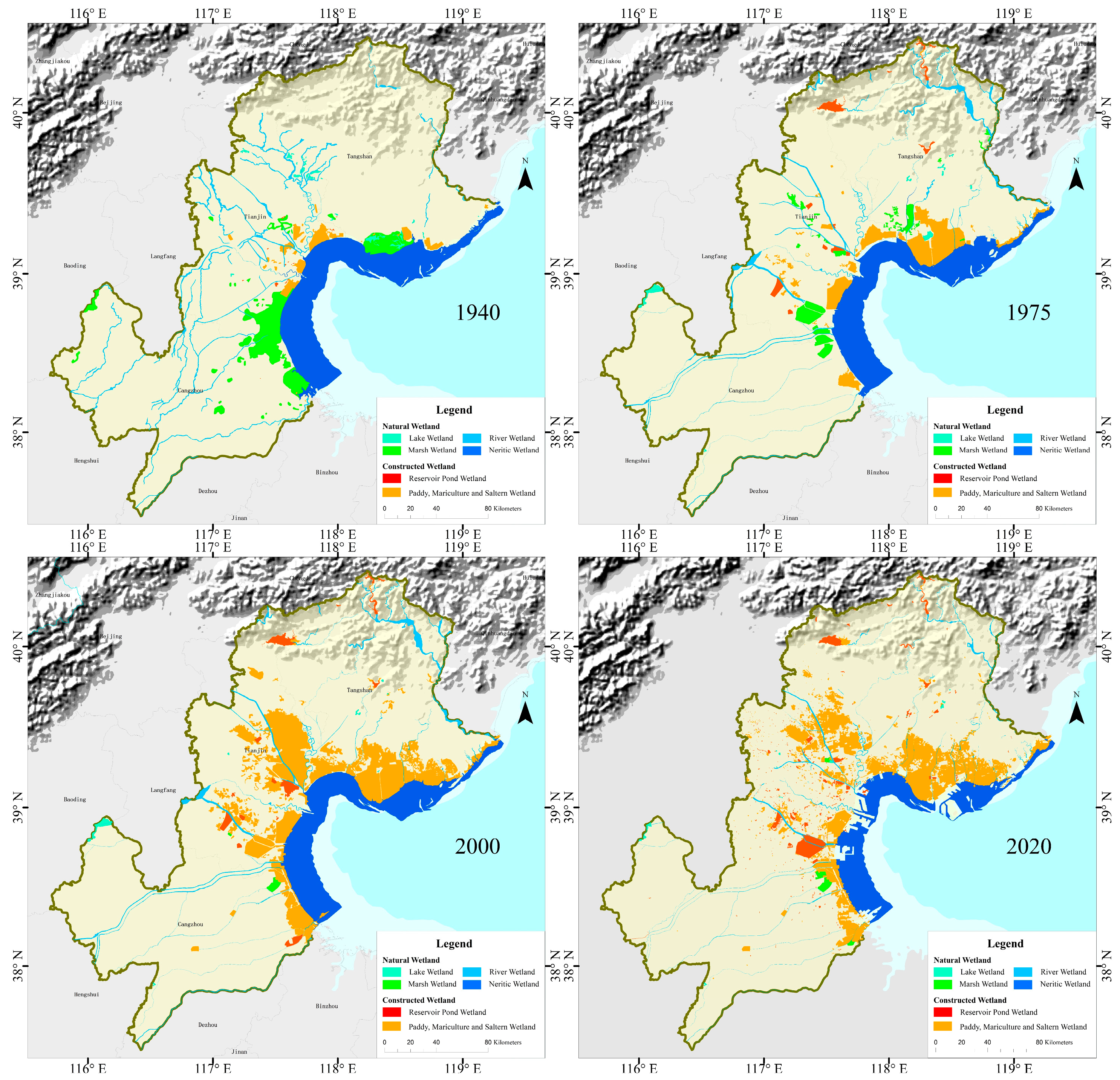
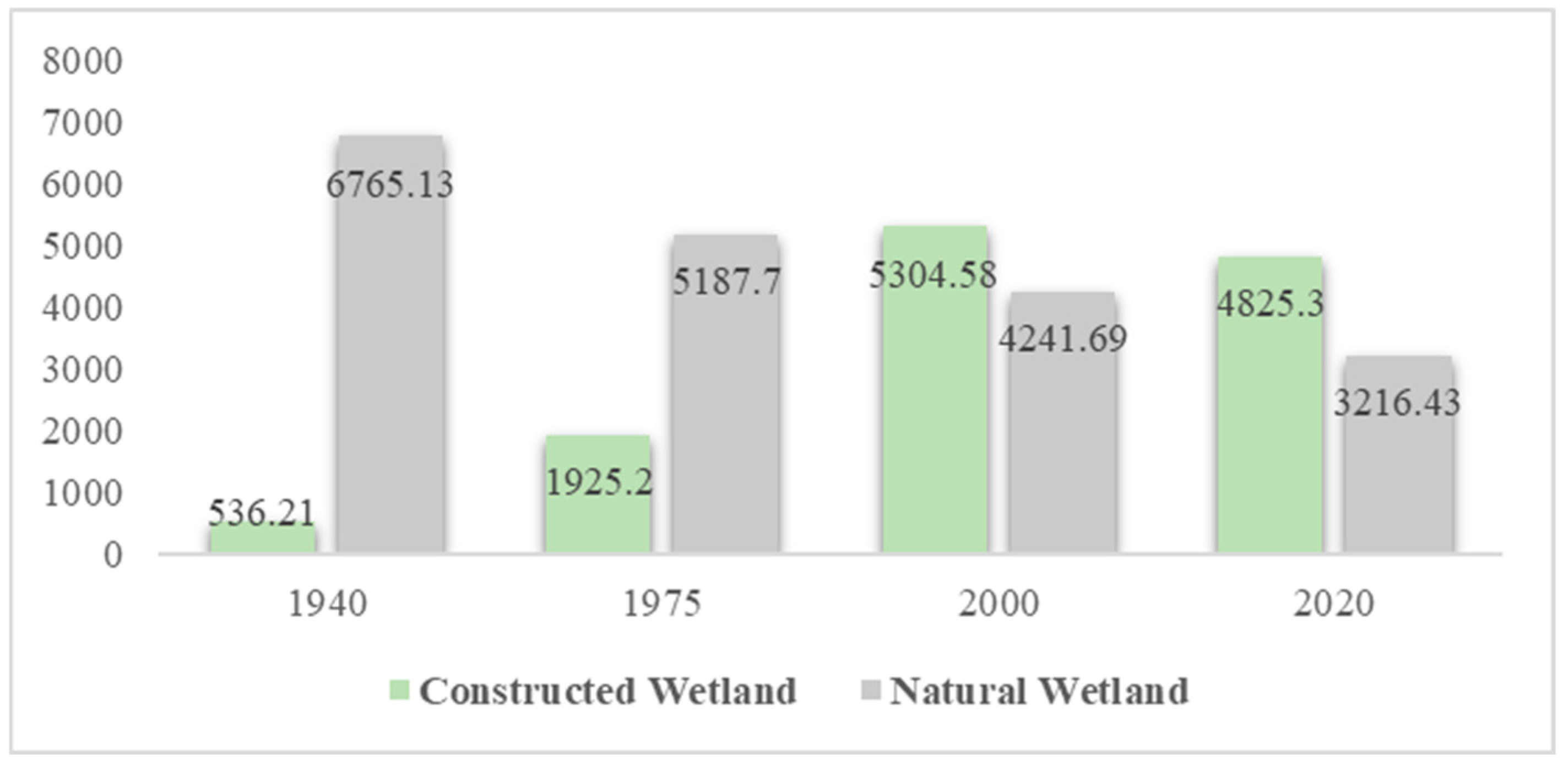
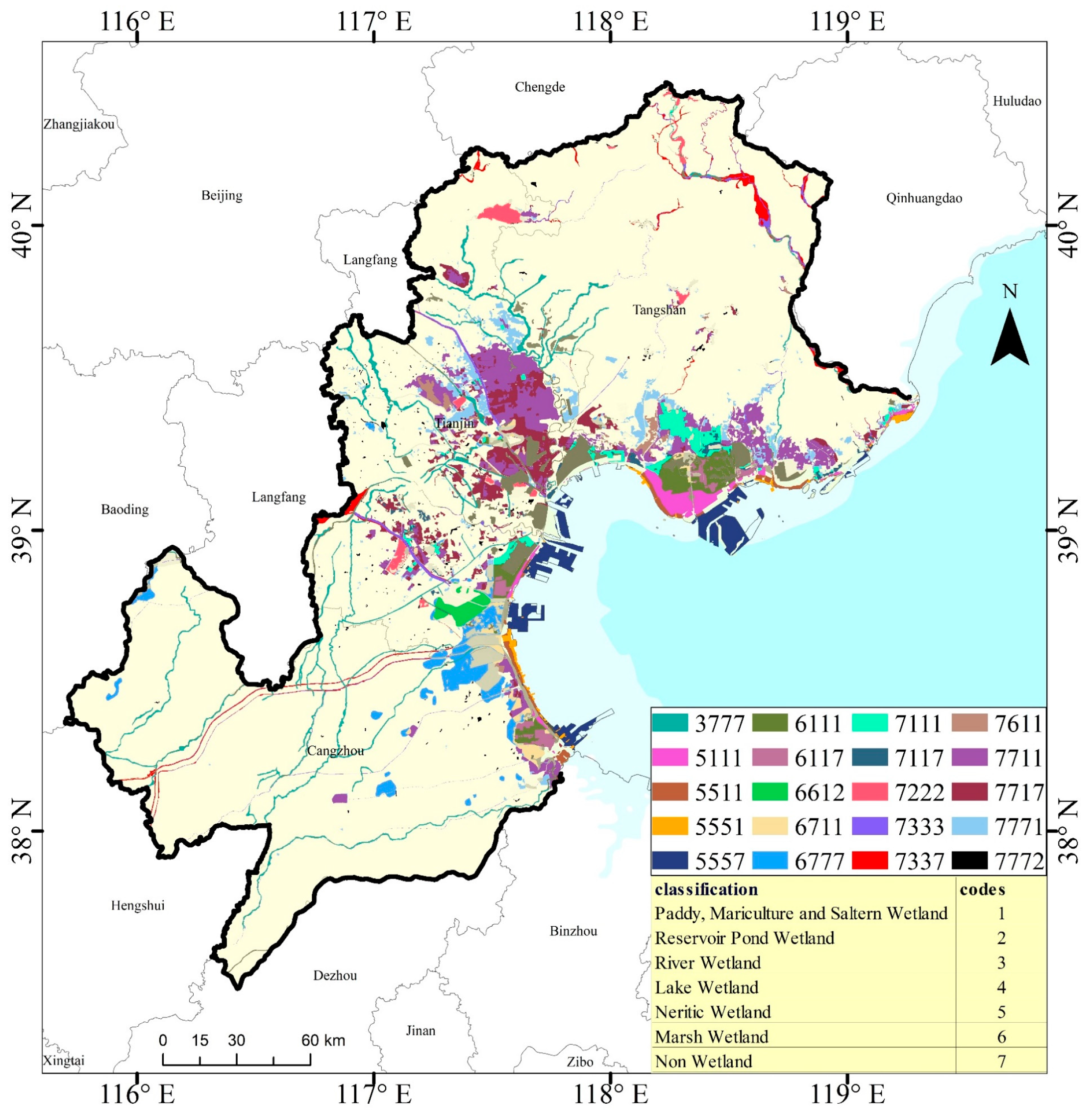
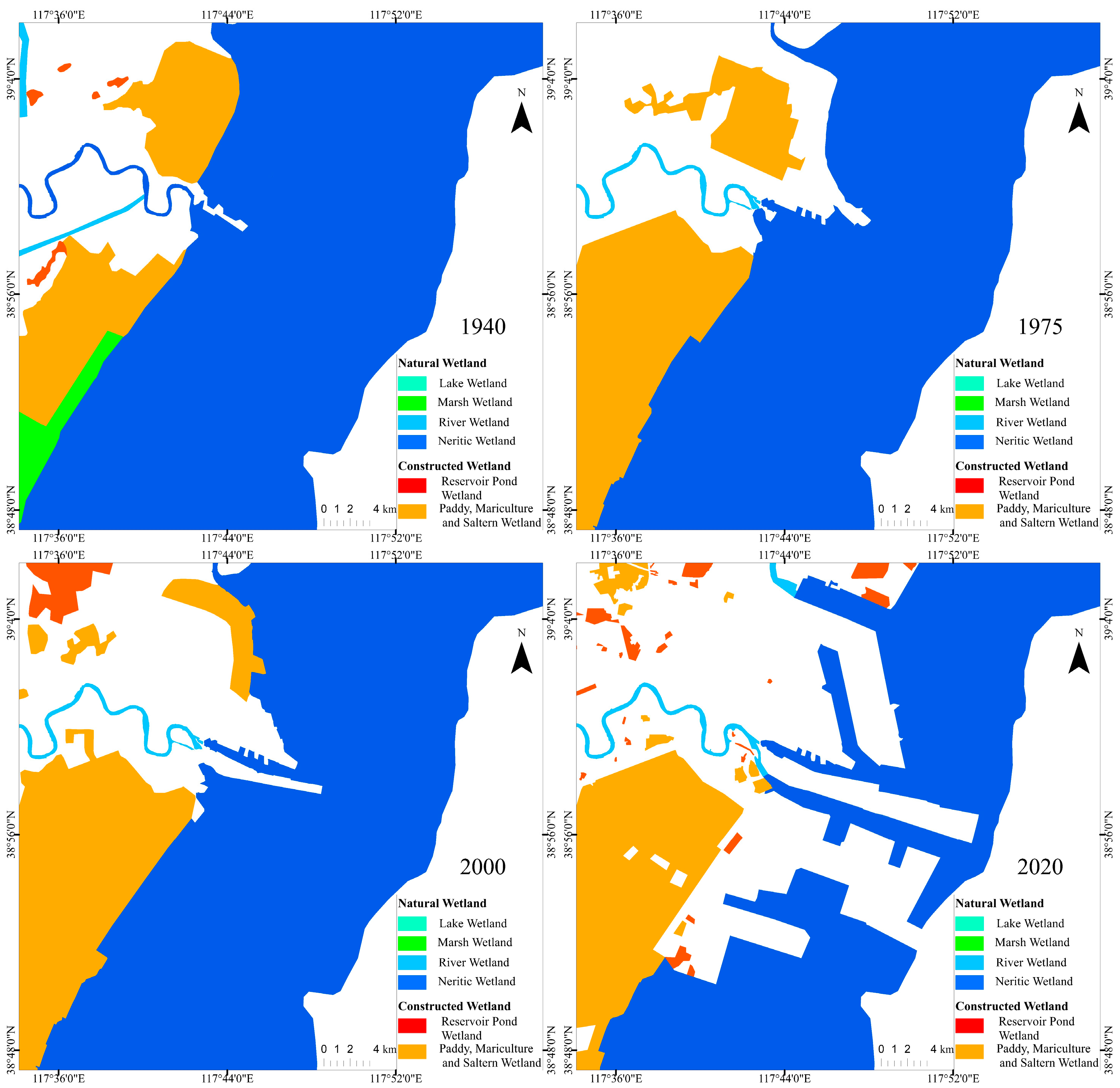
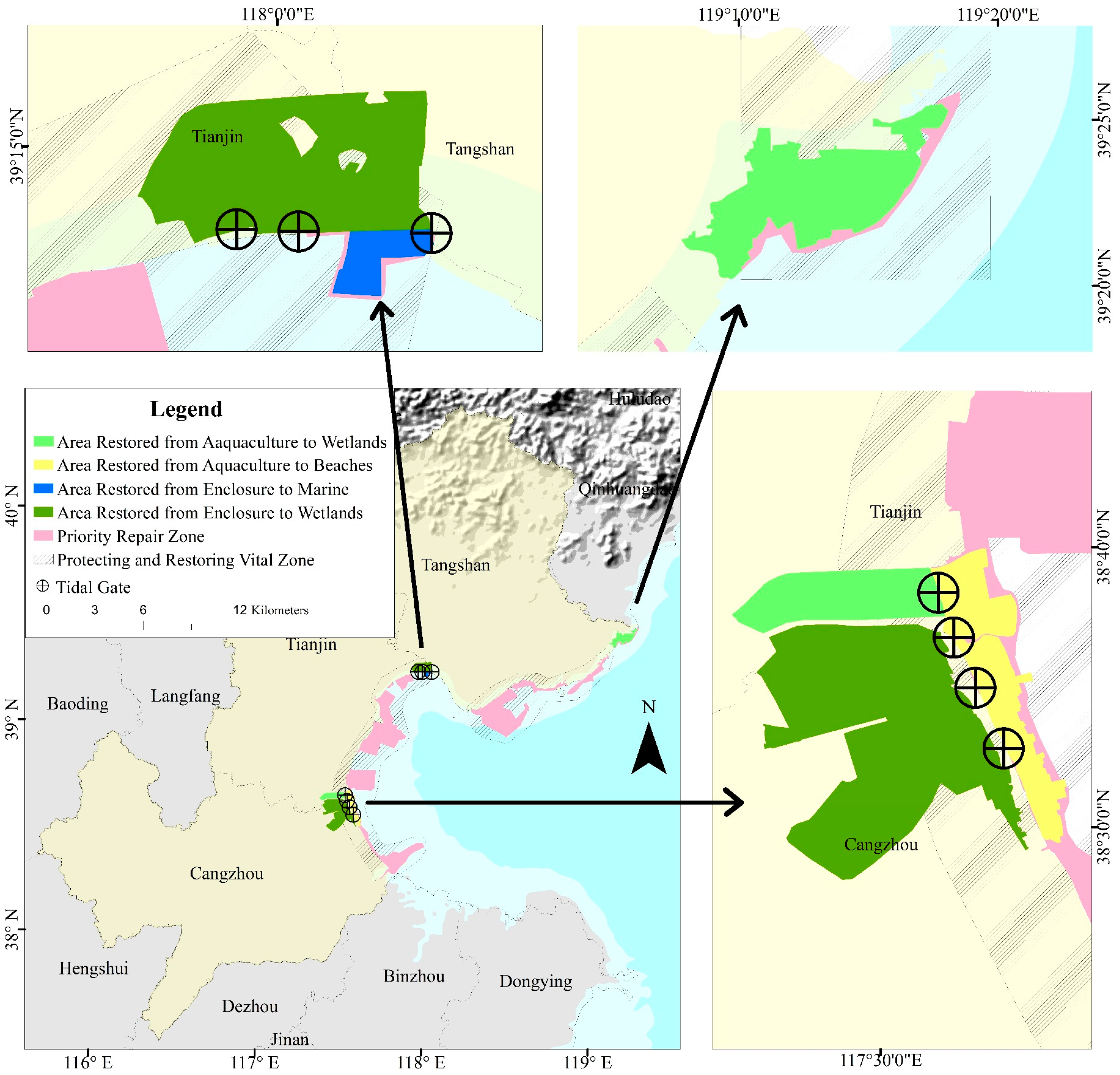
| Level 1 | Level 2 | Interpretation Markers |
|---|---|---|
| Natural Wetland | River Wetland |  |
| Lake Wetland |  | |
| Neritic Wetland |  | |
| Marsh Wetland |  | |
| Constructed Wetland | Reservoir Pond Wetland |  |
| Paddy, Mariculture, and Saltern Wetland |  |
| Primary | Secondary | 1940 | 1975 | 2000 | 2020 |
|---|---|---|---|---|---|
| Constructed Wetland | Paddy, Mariculture, and Saltern Wetland | 521.82 | 1655.9 | 4933.54 | 4194.18 |
| Reservoir Pond Wetland | 14.39 | 269.3 | 371.04 | 631.12 | |
| Natural Wetland | River Wetland | 1044.87 | 930.16 | 864.41 | 493.25 |
| Lake Wetland | 132.12 | 103.59 | 69.72 | 33.83 | |
| Neritic Wetland | 3965.25 | 3506.52 | 3253.48 | 2588.52 | |
| Marsh Wetland | 1622.89 | 647.43 | 54.08 | 100.83 | |
| Total | 7301.34 | 7112.9 | 9546.27 | 8041.73 | |
| Primary | Secondary | 1940–1975 | 1975–2000 | 2000–2020 | 1940–2020 |
|---|---|---|---|---|---|
| Constructed Wetland | Paddy, Mariculture, and Saltern Wetland | 32.40 | 131.11 | −36.97 | 45.90 |
| Reservoir Pond Wetland | 7.28 | 4.07 | 13.00 | 7.71 | |
| Natural Wetland | River Wetland | −3.28 | −2.63 | −18.56 | −6.90 |
| Lake Wetland | −0.82 | −1.35 | −1.79 | −1.23 | |
| Neritic Wetland | −13.11 | −10.12 | −33.25 | −17.21 | |
| Marsh Wetland | −27.87 | −23.73 | 2.34 | −19.03 | |
| Total | −45.07 | 97.33 | −75.23 | 9.25 | |
| 1940 | 1975 | 2000 | 2020 | |
|---|---|---|---|---|
| Tianjin | 2890.21 | 2681.75 | 4402.61 | 3508.33 |
| Constructed Wetland | 420.87 | 797.38 | 2898.92 | 2378.43 |
| Natural Wetland | 2469.34 | 1884.37 | 1503.69 | 1129.9 |
| Tangshan | 2352.85 | 3016.18 | 3412.93 | 3048.34 |
| Constructed Wetland | 113.13 | 1005.02 | 1838.71 | 1922.08 |
| Natural Wetland | 2239.72 | 2011.16 | 1574.22 | 1126.26 |
| Cangzhou | 2058.28 | 1414.97 | 1730.73 | 1485.06 |
| Constructed Wetland | 2.21 | 122.8 | 566.95 | 524.79 |
| Natural Wetland | 2056.07 | 1292.17 | 1163.78 | 960.27 |
| 1940–1975 | 1975–2000 | 2000–2020 | 1940–2020 | |
|---|---|---|---|---|
| Tianjin | −5.96 | 68.83 | −44.71 | 7.73 |
| Constructed Wetland | 10.76 | 84.06 | −26.02 | 24.47 |
| Natural Wetland | −16.71 | −15.23 | −18.69 | −16.74 |
| Tangshan | 18.95 | 15.87 | −18.23 | 8.69 |
| Constructed Wetland | 25.48 | 33.35 | 4.17 | 22.61 |
| Natural Wetland | −6.53 | −17.48 | −22.40 | −13.92 |
| Cangzhou | −18.38 | 12.63 | −12.28 | −7.17 |
| Constructed Wetland | 3.45 | 17.77 | −2.11 | 6.53 |
| Natural Wetland | −21.83 | −5.14 | −10.18 | −13.70 |
| Primary | Secondary | 1940 | 1975 | 2000 | 2020 | ||||
|---|---|---|---|---|---|---|---|---|---|
| NP | PD | NP | PD | NP | PD | NP | PD | ||
| Constructed Wetland | Paddy, Mariculture, and Saltern Wetland | 27 | 0.0037 | 38 | 0.0053 | 184 | 0.0193 | 559 | 0.0693 |
| Reservoir Pond Wetland | 15 | 0.0021 | 14 | 0.0020 | 16 | 0.0017 | 420 | 0.0521 | |
| Natural Wetland | River Wetland | 40 | 0.0055 | 100 | 0.0141 | 163 | 0.0171 | 307 | 0.0381 |
| Lake Wetland | 26 | 0.0036 | 8 | 0.0011 | 7 | 0.0007 | 14 | 0.0017 | |
| Neritic Wetland | 5 | 0.0007 | 9 | 0.0013 | 15 | 0.0016 | 8 | 0.0010 | |
| Marsh Wetland | 32 | 0.0044 | 32 | 0.0045 | 2 | 0.0002 | 4 | 0.0005 | |
Disclaimer/Publisher’s Note: The statements, opinions and data contained in all publications are solely those of the individual author(s) and contributor(s) and not of MDPI and/or the editor(s). MDPI and/or the editor(s) disclaim responsibility for any injury to people or property resulting from any ideas, methods, instructions or products referred to in the content. |
© 2024 by the authors. Licensee MDPI, Basel, Switzerland. This article is an open access article distributed under the terms and conditions of the Creative Commons Attribution (CC BY) license (https://creativecommons.org/licenses/by/4.0/).
Share and Cite
Wang, F.; Wang, F.; Zhu, K.; Yang, P.; Wang, T.; Hu, Y.; Ye, L. Spatiotemporal Dynamics and Drivers of Coastal Wetlands in Tianjin–Hebei over the Past 80 Years. Water 2024, 16, 2612. https://doi.org/10.3390/w16182612
Wang F, Wang F, Zhu K, Yang P, Wang T, Hu Y, Ye L. Spatiotemporal Dynamics and Drivers of Coastal Wetlands in Tianjin–Hebei over the Past 80 Years. Water. 2024; 16(18):2612. https://doi.org/10.3390/w16182612
Chicago/Turabian StyleWang, Feicui, Fu Wang, Ke Zhu, Peng Yang, Tiejun Wang, Yunzhuang Hu, and Lijuan Ye. 2024. "Spatiotemporal Dynamics and Drivers of Coastal Wetlands in Tianjin–Hebei over the Past 80 Years" Water 16, no. 18: 2612. https://doi.org/10.3390/w16182612
APA StyleWang, F., Wang, F., Zhu, K., Yang, P., Wang, T., Hu, Y., & Ye, L. (2024). Spatiotemporal Dynamics and Drivers of Coastal Wetlands in Tianjin–Hebei over the Past 80 Years. Water, 16(18), 2612. https://doi.org/10.3390/w16182612






